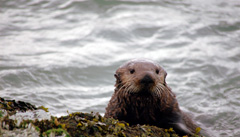DID YOU KNOW? |
SCIENTIFIC CLASSIFICATION |

--Otters are made for the water! They have sleek, streamlined bodies perfect for swimming and diving. Their back feet act like rudders and they have flattened tails that propel them through the water.
--Keeping their fur clean is important, so otters spend a lot of time grooming.
--Sea otters have a high metabolism and may eat up to 20 pounds of food a day!
|
| Class: |
Mammalia |
| Order: |
Carnivora |
| Family: |
Mustelidae |
| Genus: |
Enhydra |
| Species: |
lutris |
FAST FACTS |
| Weight: |
65 - 85 pounds with males being larger than females |
| Length: |
55 - 58 inches |
| Life Span: |
15 years |
| Gestation: |
4 to 9 months, with a delayed implantation period |
| # of young: |
1 to 5 |
| Range: |
Coastal regions throughout the eastern North Pacific Ocean |
| Diet: |
Carnivore, eats sea urchins, crabs, abalone, clams, mussels, fish and octopus |
Energy & Conservation
Sea otters were once abundant before fur hunters nearly caused them to go extinct. They have been protected since 1911 and have made a comeback.
Otters, like other marine animals, are negatively affected by oil spills. Oil mats their fur and can damage their ability to hunt for food or stay warm causing hypothermia. |
|
| |
|














